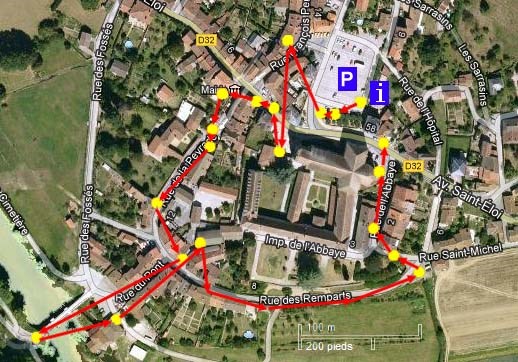Solignac : cité de Saint Eloi, orfèvre aVERTi Mystery Cache
Solignac : cité de Saint Eloi, orfèvre aVERTi
-
Difficulty:
-

-
Terrain:
-

Size:  (small)
(small)
Related Web Page
Please note Use of geocaching.com services is subject to the terms and conditions
in our disclaimer.
C'est en 632 que le Roi Dagobert donne à Saint Eloi la "villa Solemniacum" pour y fonder son monastère. Le village se développe alors autour du domaine de l'Abbaye.
It is in 632 that King Dagobert gives to Saint Eloi the "villa Solemniacum" to establish his monastery. The village develops then around the domain of the Abbey.

------------oOo------------

C’est à sa demande que Saint Eloi (né en 588 à Chaptelat, au nord de Limoges), orfèvre à l’atelier de Limoges puis évêque de Noyon, obtint en 632 du Roi Dagobert la terre de «Solemniac» lorsqu'il souhaita revenir dans son pays natal. Il y fonda un important monastère où de nombreux moines s’adonnaient à la prière et au travail de l’orfèvrerie. Mais le monastère fut pillé et ruiné par les Sarrazins puis les normands. Il va peu à peu renaître aux Xème et XIème siècles pour prospérer ensuite.
L'Association Renaissance de Solignac-Le Vigen a mis en place un circuit de plaques en céramique reproduisant des aquarelles et des photos anciennes et retraçant l'histoire de Solignac. Vous pourrez y découvrir en une trentaine de minutes le pont roman, les remparts de l'abbaye et des maisons à colombage. Un plan figure dans la galerie photos et est également disponible gratuitement à l'Office de Tourisme (au point de parking).
Vous pourrez évidemment compléter votre ballade par une visite de l'Abbatiale (Visites libres tous les jours de 9h à 18h00), « l’une des plus majestueuses églises à coupoles de France… » d'après R. CROZET, auteur de "L’art roman 1981", la seule en Limousin et qui présente un style particulièrement harmonieux, équilibré et dépouillé de tout artifice superflu. Elle renferme notamment des stalles aux miséricordes très ouvragées, une peinture murale monumentale du XVe siècle, et deux autres, plus modestes, de la fin du XVIe siècle.
Un petit travail préparatoire est nécessaire à la découverte de cette cache.
La chanson "Le bon Roi Dagobert", comprend de nombreux couplets.
Notez le nombre de couplets : A = _ _
Dans les paroles de cette chanson combien de vers se terminent par le son "VER" ?
Notez ce nombre B = _ _
En suivant le circuit des plaques émaillées, vous collecterez les indices nécessaires à la reconstitution des coordonnées finales.

Durant votre balade, vous verrez une ancienne carte postale de l'abbaye à l'époque de l'usine de porcelaine (on y distingue la cheminée du four). Sur cette carte postale est collé un timbre.
Notez la valeur de ce timbre en centimes : C = _
Le village a abrité plusieurs fabriques de porcelaine entre 1824 et 1934.
Notez le nombre de fabriques : D = _
Allez jusqu'au pont roman et comptez le nombre d'arches.
Notez ce nombre : E = _
Solignac se trouve sur le chemin de Saint Jacques (une variante de la voie passant par Limoges et Aixe-sur-Vienne : série de 13 caches Via Lemovicensis). On trouve dans le village de nombreux témoignages de ce passage. Les pèlerins accédaient au monastère par la porte Saint-Jean, l'une des portes de la ville. Sur la façade où se trouve cette porte, le symbole de St Jacques est sculpté à plusieurs reprises.
Notez le nombre de fois où ce symbole est sculpté : F = _
Sur le circuit, vous découvrirez une grande maison d'angle qui avait une fonction particulière.
Etait-ce : 1 - un séchoir à peaux, 2 - une fonderie d'or, 3 - un cachot, 4 - un observatoire astronomique ?
Notez ce numéro de la bonne réponse : G = _
Enfin, deux plaques reproduisent des photos d'une procession Rue Saint Eloi.
Notez le dernier chiffre de l'année de cette procession : H = _
La cache se trouve en N 45°GC'DA / E 01°B'HFE
La cache est une boîte d'environ 6 x 9 cm qui permet la dépose et l'échange d'objets.
Suivant le thème/challenge des caches "VERTes", le dépôt d'objets exclusivement "VERTs" sera apprécié.
Attention : l'endroit est très fréquenté : soyez discret et replacez bien le camouflage pour que la cache vive longtemps pour le plaisir de tous.
------------------------
ENGLISH VERSION
------------------------
It is on his request that Saint Eloi (born in 588 to Chaptelat, in the North of Limoges), silversmith for the workshop of Limoges then bishop of Noyon, obtained in 632 of King Dagobert the place of "Solemniac" when he wished to return in his native country. He established an important monastery there where numerous monks devoted to the prayer and to the silversmith's trade. But the monastery was plundered and ruined by Sarrazins then Norman. It will prosper again little by little during the Xth and XIth centuries.
The Association Renaissance of Solignac-Le Vigen set up a circuit of ceramic plates reproducing watercolors and old pictures and redrawing the history of Solignac. You can discover in about thirty minutes the roman bridge, the ramparts of the abbey and half-timbered houses. A map is available in the photo gallery and is also available free of charge at the Tourist Office (in the point of parking lot).
You can obviously complete your walk by a visit of the Abbey church (free Visits every day from 9 am till 6:00 pm), " one of the most majestic churches with domes of France " thanks to R. CROZET, author of " L'art roman 1981 ", the only one in Limousin and which presents a style particularly harmonious, well-balanced and deprived of any superfluous subtlety. It contains in particular stalls in the very decorated mercies, monumental mural of the XVth century, and other, more modest two, of the end of the XVIth century.
A small preliminary work is necessary for the discovery of this geocache.
The song "Le bon Roi Dagobert ", consists of numerous stanzae.
Note the number of stanzae : A = _ _
In the words of this song how much of verses end by the sound "VER" ("green" in French) ?
Note this number : B = _ _
By following the circuit of enamel plates, you will collect the indications necessary for the reconstruction of the final coordinates.

During your walk, you will see an old postcard of the abbey at the time of the porcelain factory (there you can distinguish the chimney of the oven). On this postcard is stuck a stamp.
Note the value of this stamp in centimes : C = _
The village sheltered several porcelain factories between 1824 and 1934.
Note the number of factories : D = _
Go down to the roman bridge and count the number of arches.
Note the figure : E = _
Solignac is on Saint Jacques's path (a variant of the way crossing Limoges and Aixe-sur-Vienne: series of 13 geocaches Via Lemovicensis). We find in the village numerous testimonies of this passage. The pilgrims reached the monastery by the "Porte Saint Jean", one of the city gates. On the facade of this door is sculptured several times St Jacques's symbol.
Note the number of times when this symbol is sculptured : F = _
On the circuit, you will discover a big street corner house which had a particular function. It was : 1 / a dryer for skins, 2 / a gold foundry, 3 / a prison, 4 / an astronomical observatory?
Note the figure of the good answer : G = _
Finally, two plates reproduce photos of a procession in Rue Saint Eloi.
Note the last figure of the year of this procession : H = _
The geocache is N 45°GC, DA / E 01°B, HFE
The geocache is a box about 6 x 9 cms which allows the removal and the exchange of objects.
According to the challenge of the "GREEN" (VERT in french) geocaches, the deposit of exclusively "GREEN" objects will be appreciated.
Attention: the place is very frequented: be discreet and please, replace well the camouflage so that the geocache will live for a long time for the pleasure of all.

Additional Hints
(Decrypt)
[FR] Ar pbasbaqrm cnf nirp yn "pvfgr" (Œhs Xvaqre) - Punafba qnaf yn tnyrevr
[EN] Orjner gur "pvfgr" (Xvaqre rtt) - Fbat va gur tnyrel